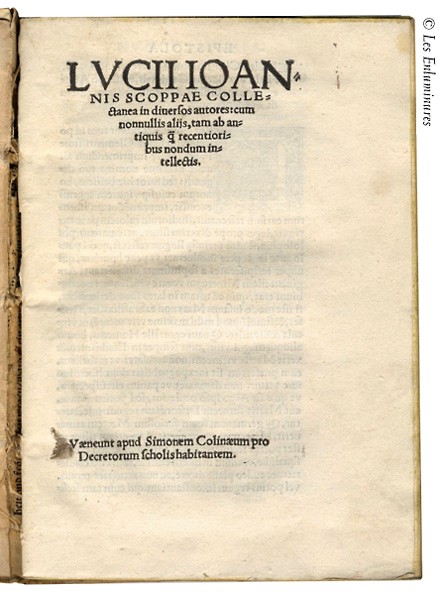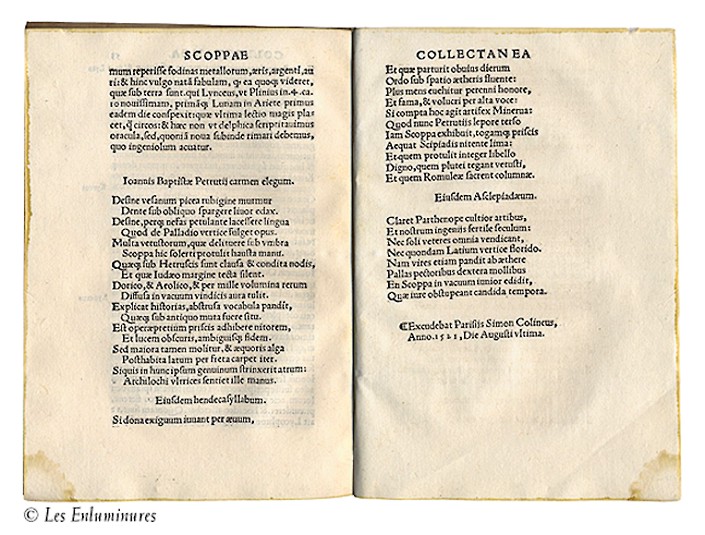Lessico
Lucio Giovanni Scoppa
Grammatico e retore napoletano morto nel 1543 circa. Viene citato coi seguenti nomi: Lucius Ioannes Scoppa; Ioannes Scopa; Ioannes Scoppa; Lucius Ioannes Scoppa Parthenopaeus.
Scrisse De epistolis componendis, ornandis orationibus ... De arte metrica in calce., Venetiis 1567 e 1586. A causa della citazione del suo Dictionarium Latinoitalicum da parte di Gessner a proposito del cappone - Capus gliscens, lo capone impastato, nutrito de pasta - a noi interessa lo Spicilegium seu thesaurulus latinae linguae ... atque italicae noviter ab auctore recognitus, atque ... locupletatus ... Tomus primus (-secundus). - Venetiis: apud Petrum Bosellum, 1558.
Nei primi anni del secolo XVI fu appunto autore di uno Spicilegium - cioè una spigolatura, una raccolta, da spica = spiga + legere = raccogliere, raccolta di brani scelti, antologia - che godette di un'ampia fortuna editoriale nel corso del Cinquecento. Il frontespizio seguente è del 1642 e rappresenta una ristampa della prima edizione di Simon de Colines.

Unusual hybrid book from the first century of printing, this volume combines a wallet-style binding from a Middle Rhenish illuminated liturgical manuscript and a printed classical text. Medieval wallet-style bindings are scarce, illuminated ones even rarer. Only one copy of this first French edition of Scoppa’s works, published in Paris by the leading humanist printer Simon de Colines, is recorded in American public collections.
Published in Paris, but perhaps bound in the area of the Middle Rhine, because of the provenance of the illuminated parchment leave from this location that serves as the binding of the imprint.
The present edition, one of Simon de Colines’s earliest books, reprints a collection of philological and critical notes on ancient Greek and Roman authors, comprising the first published work by the celebrated Neapolitan humanist Lucio Giovanni Scoppa, which he wrote at the age of 13. It was first published in Naples by Sigismundus Mayr in 1507 and reprinted there ten years later. Scoppa is also the author of a Latin grammar which he composed at the age of 18 years. At his death Scoppa bequeathed all his worldly goods and wealth to the monastery of San Pietro in Vincoli, to fund the teaching of grammar, rhetoric, and poetry in that institution to 200 needy Neapolitan students.
Simon de Colines (born c. 1470/90; died 1546) was a Parisian printer of the French Renaissance associated with the elder Henri Estienne, whom he succeeded (c. 1520 he married the widow of Estienne). He inherited the types of Henri Estienne, but he created for himself many elegant roman and italic types and a Greek type with accents. Some of his types were designed by Geoffrey Tory. His books, often small in format, are superbly crafted, and his press turned out many editions of learned humanist works mostly in Latin and some in Greek. A staunch anti-Lutheran, he also published editions of the Bible and even a Book of Hours. He worked at the Sign of St. John the Baptist (from 1520), the Sign of the Golden Sun (from 1526), and finally at the Sign of the Four Evangelists (from 1539). Contemporary catalogues of his imprints allow us to calculate that he printed approximately 400 editions in his lifetime.
